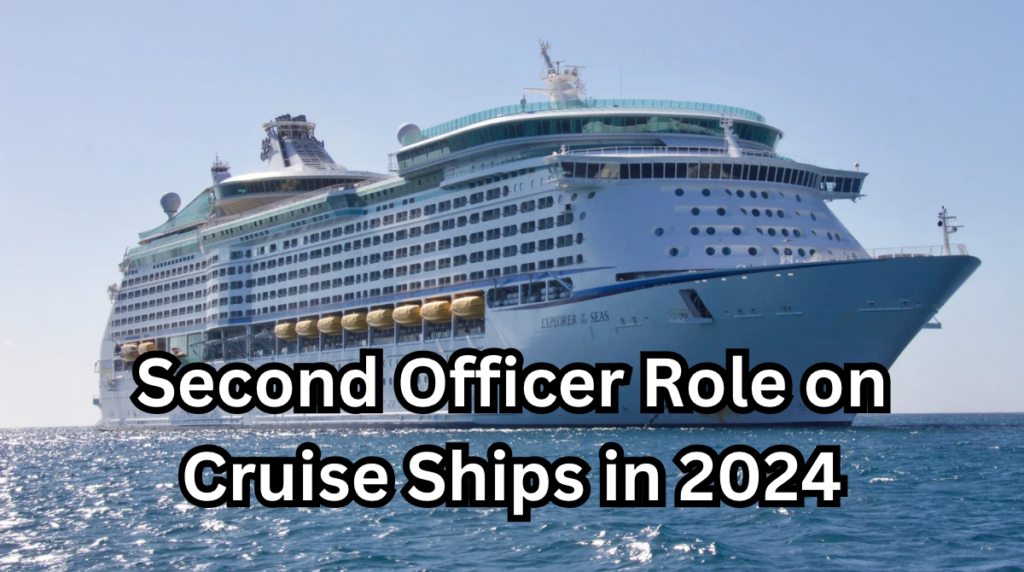Cruise ships are like floating cities, providing passengers with luxurious experiences and memories. However, the seamless operation of these ships depends on a well-trained team of officers, each with distinct responsibilities. The Second Officer plays a vital role in navigation, safety, and day-to-day operations. But what exactly does a Second Officer do, and what does it take to become one? This article delves into the responsibilities, qualifications, and career prospects of a Second Officer on a cruise ship.
Table of Contents
What is a Second Officer Role on Cruise Ships
The Second Officer is a key ship deck department member, tasked with navigation, safety, and security. Often referred to as the ship’s Safety Officer, the Second Officer ensures that the ship stays on course and that all safety protocols are in place. They are responsible for maintaining navigational equipment, managing watch duties, and coordinating emergency preparedness. Their role is crucial to the safe and efficient operation of the cruise ship.
Read Also: Hotels Careers
Top companies: Royal Caribbean cruise
Hierarchy on a Cruise Ship
On a cruise ship, the chain of command is critical. The hierarchy is well-defined, ensuring clear lines of responsibility:
- Captain: The ultimate authority on the ship.
- Chief Officer (Chief Mate): Second in command, responsible for the ship’s overall operation.
- Second Officer: Focuses on navigation and safety, reporting to the Chief Officer.
- Third Officer: Assists with navigation and general watch duties.
The Second Officer ranks below the Chief Officer but plays a vital role in the ship’s daily operations.
Key Duties of a Second Officer
- Navigation and Bridge Watchkeeping: The Second Officer monitors the ship’s course, speed, and position, ensuring safe passage.
- Safety and Security Duties: Oversees safety equipment, conducts drills, and ensures compliance with safety regulations.
- Emergency Preparedness: Coordinates the ship’s response in emergencies, including fire, evacuation, and medical incidents.
- Maintenance of Navigation Equipment: Regularly checks and maintains navigational tools like radar, GPS, and charts.
Educational Requirements
To become a Second Officer, a solid educational foundation is essential:
- Marine Studies Degree: Typically, candidates must have a degree in Marine Navigation, Marine Engineering, or a related field.
- Nautical Science: Courses in nautical science are often required to gain specialized knowledge in ship operations and navigation.
Age Limit
There is no strict age limit to become a Second Officer, but most candidates begin their careers in their early 20s. However, candidates must be physically fit and capable of handling the demanding nature of the job.
Certification Required
Certifications are crucial for advancing in a maritime career. Some essential certifications include:
- Standards of Training, Certification, and Watchkeeping (STCW): This is a mandatory certification for all maritime professionals.
- Officer of the Watch (OOW) Certificate: Required to take on the role of a Second Officer.
- Medical Fitness Certificate: Proves the candidate is physically fit to work at sea.
Work Experience
Experience is key in maritime roles. To become a Second Officer, one must usually:
- Accumulate Sea Time: Candidates often need at least 12 months of sea time as a Third Officer or a cadet.
- Hands-on Experience: Practical experience in navigation, safety, and ship operations is essential.
Future Opportunities
The career of a Second Officer offers numerous growth opportunities:
- Chief Officer/Chief Mate: After gaining experience, a Second Officer can be promoted to Chief Officer.
- Captain: With further experience and certifications, one can eventually become the Captain.
- Shore-Based Roles: Some may transition to roles in maritime management, port operations, or marine surveying.
Salary and Pay Scale
The salary of a Second Officer varies depending on the company, ship size, and experience:
- Average Salary: A Second Officer typically earns between $3,500 and $6,500 per month.
- Additional Benefits: These often include free accommodation, meals, and insurance coverage. Some companies also offer bonuses and paid leave.
Daily Routine of a Second Officer
A typical day for a Second Officer includes:
- Bridge Watchkeeping: Monitoring the ship’s course and ensuring safe passage.
- Safety Checks: Inspecting life-saving equipment and conducting safety drills.
- Navigation Planning: Updating charts, checking weather forecasts, and planning routes.
- Collaboration: Coordinating with other departments to ensure smooth operations.
Challenges Faced by Second Officers
- Navigational Challenges: Managing safe passage through difficult waters.
- Emergency Situations: Being prepared to handle fires, medical emergencies, and other crises.
- Long Hours and Extended Time Away from Home: The job demands dedication and resilience, often requiring long periods away from family.
The Importance of Safety and Compliance
The Second Officer ensures that the ship complies with international maritime laws, including safety protocols, environmental regulations, and security measures. This role is vital in maintaining the ship’s certification and ensuring passenger and crew safety.
Career Progression for Second Officers
The career path from Second Officer to Captain involves:
- Further Training: Gaining additional certifications like the Chief Mate Certificate.
- Experience: Accumulating sea time in higher-ranked positions.
- Leadership Roles: Demonstrating leadership skills and gaining experience in managing larger teams.
Second Officer’s Role in Passenger Experience
While not directly interacting with passengers daily, the Second Officer contributes to the overall cruise experience by ensuring safe navigation and a smooth journey. Their behind-the-scenes work is critical to delivering a successful cruise.
The Role of Technology in a Second Officer’s Job
Modern technology plays a significant role in the job:
- Navigation Tools: Radar, GPS, and electronic charts are essential for accurate navigation.
- Communication Systems: Reliable communication with other ships and port authorities is crucial.
- Automation: Technology helps monitor ship systems and reduces manual tasks, though hands-on skills remain necessary.
Work-Life Balance for Second Officers
Balancing life at sea with life ashore can be challenging:
- Life Onboard: Long hours and isolation can be difficult.
- Life Ashore: Time off is usually substantial, allowing officers to spend quality time with family.
- Coping Strategies: Staying connected with loved ones and engaging in onboard activities help maintain mental well-being.
Conclusion
The role of a Second Officer on a cruise ship is both challenging and rewarding. From ensuring safe navigation to overseeing safety measures, the Second Officer is a crucial part of the ship’s operations. With the right qualifications, certifications, and experience, this role offers excellent career growth opportunities, both at sea and on land. If you’re considering a career in the maritime industry, becoming a Second Officer could be your gateway to a fulfilling and adventurous career.
FAQs
- What qualifications are needed to become a Second Officer?
You need a degree in marine studies, an STCW certification, and an Officer of the Watch (OOW) certificate. - How much experience is required to become a Second Officer?
Typically, you need at least 12 months of sea time as a Third Officer or cadet. - What is the average salary of a Second Officer?
The average salary ranges from $3,500 to $6,500 per month, depending on experience and the cruise line. - Can a Second Officer become a Captain?
Yes, with further certifications and experience, a Second Officer can progress to Chief Officer and eventually Captain. - What are the main challenges faced by a Second Officer?
Navigational challenges, emergency situations, and long periods away from home are some of the key challenges.



